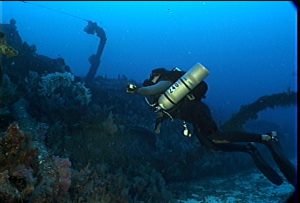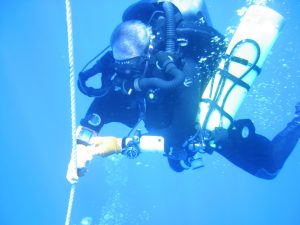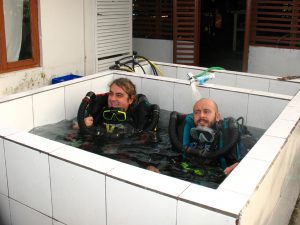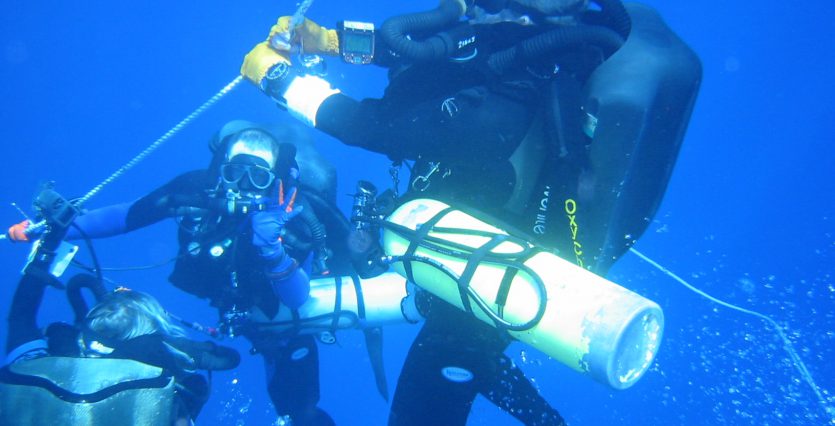Part 4 – Questions and Answers – continued
 Isobaric counterdiffusion (ICD) is just a theoretical concoction and never observed?
Isobaric counterdiffusion (ICD) is just a theoretical concoction and never observed?
No. It’s been demonstrated and observed in laboratory experiments with helium and nitrogen. Improper gas switches from nitrogen-based mixes to helium-based mixes (heavy-to-light) have been implicated as DCS causative. Simple calculations with diveware packages will easily quantify the effects on just dissolved gases.
The groupless, no-calculation recreational NAUI RGBM Tables are conservative?
Yes again, and very easy to use versus the older versions of the NAUI Tables based on the USN model. A simple set of repetitive dives out to the limits of the NAUI RGBM Air and Nitrox Tables compared to allowable times in the old NAUI (USN) Tables will underscore the conservancy. For teaching tables, the NAUI RGBM Air and Nitrox Tables are optimal for neophytes and useful for experienced divers.
The DCS hit rate in chamber tests is lower than open ocean tests for the same profile?
Another yes as noted by Peter Bennett. The variability of environmental impacts, diver comfort and awareness, buoyancy modifications, and equipment demands in open water versus the tranquility and comfort of chamber and pod beds weigh more heavily on open water tests.
All training agencies teach dive tables?
Not anymore. Some mandate and teach dive computers for ease and simplicity as mainline policy. Guess it’s sort of like using calculators for arithmetic instead of knowing how to add, subtract, multiply, and divide. Your call, not ours.
GFs have been tested and correlated with VPM and RGBM?
No, but that is an exercise that might well be a worthwhile undertaking to provide reference metrics against consistent, uniform, and extensively used dive computer and software algorithms. GFs are arbitrary and not self-consistent. Correlating GFs with tried, tested, and safe BMs has been on a bucket list here at LANL for some time. We’ll see.
 Deep stops control the bubble and shallow stops treat the bubble?
Deep stops control the bubble and shallow stops treat the bubble?
Certainly true from a pure physics point of view, but biochemistry and metabolic processes affect the tissue and blood in ways that have not been quantified nor incorporated into BMs (nor GMs). On the face of it, the statement (attributed to some in the medical community) is a simple description of staging differences between BMs and GMs. For arbitrary dives, equal surfacing risk BM protocols are always shorter then corresponding GM protocols. That’s noteworthy for whatever reasons.
Dive computers and diveware extrapolate outside nominal diving envelopes for the mixture and device (OC and RB) employed?
They extrapolate to any diving activity inside or outside nominal envelopes or they may shut down if depth exceeds programmed algorithm limitations. The user manual often specifies algorithmic ranges of depth and altitude for which data correlations exist. Diving beyond the envelope is risky business.
Some dive computers offer both GM and BM algorithms as diver choice?
Yes, as seen earlier. For increasing depth and time, differences in staging regimens increase, obviously. These choices are best made by seasoned technical and professional divers.
Computer models have been basically validated?
Yes, but a touchy question, and it depends on your viewpoint of validation. Certainly USN, ZHL, VPM and RGBM are considered validated from most user perspectives having been computer dived safely for many years without DCS and oxtox spikes and an incidence rate below 1 percent roughly. The same is probably true of any computer model that has seen similar safe performance over time. On a more scientific level, USN, ZHL, VPM and RGBM have all been correlated with data of low DCS prevalence. Laboratory and wet tests of models are selective and usually center on one or another profiles and not the full spectrum of diving across mixed gases, OC, RB systems, and deep and shallow exposures to name a few. Single tests on a single profile beg the question for some. That is where data banks (DB) are important. We mentioned wet and dry test, data, and implications for diving earlier.
 Bubble model staging usually leads to deeper stops and shorter overall decompression run times than classical M-value models?
Bubble model staging usually leads to deeper stops and shorter overall decompression run times than classical M-value models?
Yes, in the broad sense, but only categorically true when equal risk profiles are compared. That requires both deep- and shallow-stop data and analysis.
The TM was sometimes problematic with drop out at 35 fsw?
Yes, problems occurred in some hyperbaric chamber tests.
The half-deep stop for recreational diving is just precautionary?
No, not quite. The Bennett and Marroni testing showed that Doppler scores were systematically lowered with half-deep stops in the two minute range.
Recreational shallow safety stops are also precautionary?
Maybe, but hard to tell. Statistics on recreational diving to the NDLs suggest the DCS incidence rate is in the noise level. Others point out that shallow safety stops force diver buoyancy control as a beneficial spinoff.

Bubble models are riskier than dissolved gas models or vice versa?
Nada. Seems both are being dived safely with decompression meters, tables, and dive planning software. If there were DCS spikes in either usages, we would hear about it rapidly from all quarters, particularly the meter folks. Reasons for this are obvious.
Gel bubbles and body bubbles are the same?
Nope, body bubbles are perfused and metabolic. Subtle differences are seen in structures of bubble skin.
God created helium for diving but the Devil replaced it with nitrogen?
Just could be, and if so, Satan also made helium very expensive.
Hope these are interesting and useful to the tech diver. Safe and fun diving.
Please click here to review Part One, Part Two, or Part Three from the series.


